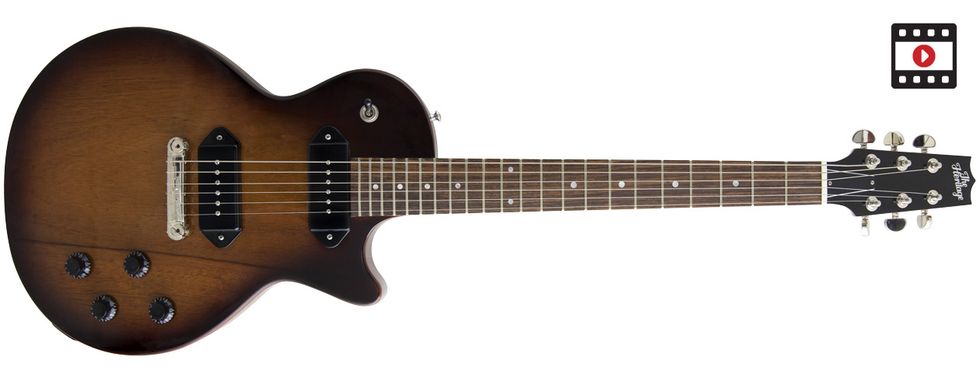RatingsPros:A classic formula very well executed. Cons: Not too much deviation from the original design inspiration. Street: $1,899 Heritage H-137SC heritageguitars.com | Tones: Playability: Build/Design: Value: |
Two pickups, four dials, and a slab of mahogany. It’s a classic rock ’n’ roll guitar format. Players have dug it since 1955, when Gibson introduced the Les Paul Special as a cheaper alternative to its flagship solidbody, the Les Paul. In the decades since, guitarists from John Lennon to Johnny Thunders have championed the Special. Why? Because it’s simple and it’s badass.
Simple and badass are good ways to describe the new Heritage H-137SC, too. The two P-90s and the single-cutaway mahogany body are clear homage to the Special. (Little surprise, given that Heritage was started by Gibson defectors in 1985). And just like that Gibson classic, this guitar is a ticket to rock ’n’ roll happiness.
Nuts ’n’ Bolts
Our review example arrived in a sturdy hardshell case and was aglow in a nitrocellulose tobacco sunburst finish. (It’s also available in TV yellow.) Heritage touts the H-137SC as “lightweight,” but that’s subjective. The 1-piece mahogany body weighs in at about 9.5 pounds—a pound more than my own ’58 Les Paul Special and about 2.5 pounds heavier than the average Stratocaster. The weight feels worth it, though. It adds to the sturdy feel of the build and, quite possibly, the guitar’s tone.
The fretboard of the 24 3/4" scale-length mahogany neck is rosewood and has a 12" radius. It’s got 22 frets, in the Gibson and Heritage traditions, and they’re Jescar medium jumbos, which encourage swaggering string bending. The neck profile is a shallow C shape, which is quite easy to mange for pickers that favor thin necks. The nut is Corian and the guitar has a wraparound bridge and Grover tuners, finished in shiny nickel. The 500k pots are made by CTS, and the caps are .022 µF Vishays—both dependable and widely used brands. The setup, by the way, was excellent.
The Playoff
Most of my guitars are pretty basic, so with its comfy neck, medium-jumbo frets, and simple controls, the H-137SC felt and sounded instantly gratifying. I took the guitar straight to a gig, and it proved very tuning stable—holding standard and open-G tunings while I smacked it around with abandon, just as an axe like this should be.
Really, though, smacking the heck out of this guitar isn’t a requirement. It’s not just for punk and rough-and-tumble rock. Tone attenuation makes it sweet and tubby, and you can flip the 3-way selector switch for country, jazz, or whatever-y’all-want sounds thanks to the versatile pair of Lollar P-90s. That said, this guitar’s voice sounded most classic when plugged into a Marshall or my Carr Vincent with the overdrive circuit on. With these toothy amp tones, the Heritage just plain snarls.
My own ’58 Gibson Les Paul Special is a familiar favorite. So I had to let these two instruments—which have an identical 1 3/4" body thickness, near-identical necks, and double P-90s—wrestle. Both guitars sounded ace, plugged into just about anything, and the Heritage more than easily held its own against the vintage Gibson. I played both instruments into an Orange Micro Terror powering up a 1x12 Celestion 25-watt custom cabinet, a Fender Twin Reverb, a Marshall Super Lead paired with the same Celestion, and the Carr Vincent, which has an Eminence Red Coat the Wizard 75-watt speaker. The Heritage has a bold voice that sounds like it could cut through just about any live mix, with plenty of edge and sustain, and the sonic difference between the new Heritage and the vintage Gibson was minimal. The ’58 had a slightly brighter profile overall, with a lot of air in the notes, while the Heritage had a darker, slightly fatter tone—but the contrast was a matter of aural microns. I’d play either guitar any day, anywhere, anytime.
The Verdict
Guitarists who want a classic-sounding, classic-playing, and classic-looking 6-string will dig the Heritage H-137SC. Period. It’s a no-frills, well-built, rock ’n’ roll machine that should withstand many decades of hard playing. At $1,899, it costs more than Gibson USA’s most affordable Les Paul Special, which retails for about a grand, but it’s much less than a Gibson Custom Shop version. It’s a matter of taste and budget. If P-90 tones aren’t your bag—or you’re looking for the versatility of coil tapping, or a fresher body design—this ain’t your rig. But the Heritage H-137SC is 100 percent ready to rock if you are.
Watch the Review Demo:








![Rig Rundown: Russian Circles’ Mike Sullivan [2025]](https://www.premierguitar.com/media-library/youtube.jpg?id=62303631&width=1245&height=700&quality=70&coordinates=0%2C0%2C0%2C0)


























